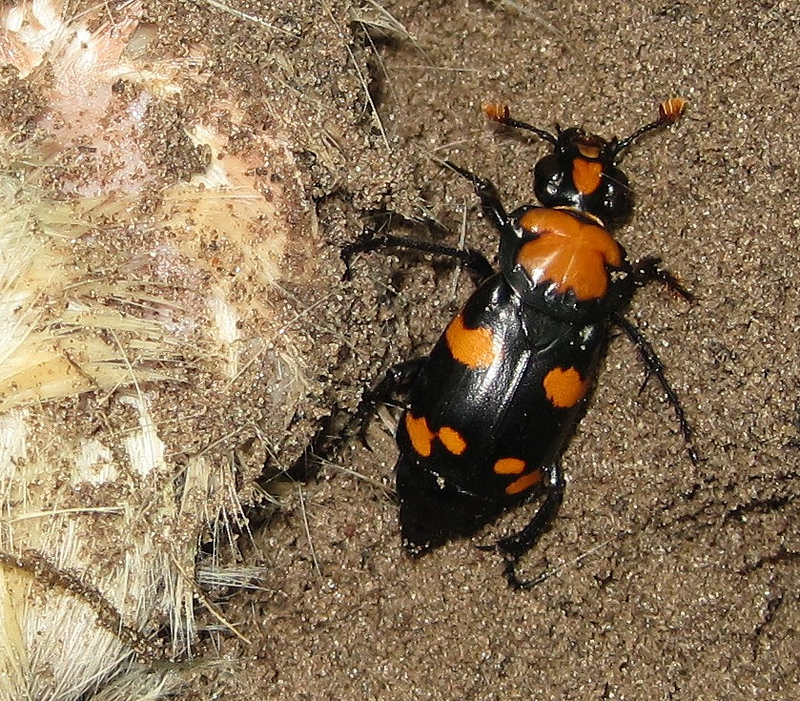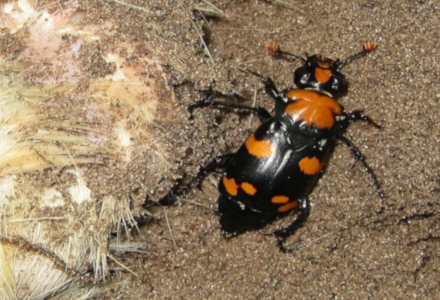
Photo Credit: USFWS
CC License: https://bit.ly/36yztkc
American Burying Beetle Facts
- The term American Burying Beetle serves as the most frequently used common name for this remarkable insect. It also goes by the alternate name of the giant carrion beetle. Both remain much more pronounceable name than its scientific name, though.
- That’s the tongue-twisting term of the Nicrophorus americanus. The French entomologist, Guillaume-Antoine Olivier made the first recognition of it as a separate and distinct species. This scientifically notable action took place in the year 1790.
- This truly fascinating invertebrate stands out from its many peers. It further does so due to a combination of several reasons. Unfortunately, though, not all of them qualify as good. It nevertheless remains a fascinating work of Nature and evolution.
- This creature remains known among researchers for its approach to parenting. That’s because it represents one of the few known varieties of beetle to actually display parental care for the offspring. The vast majority of related species do not.
- Sadly, it also deserves attention for another regrettable fact. That’s because of the fact that it continues to rapidly disappear in the wild. Its endemic range once covered much of North America. But now, it only inhabits a tiny fraction of its former range.
- Due to its rapid and continued decline in population, the IUCN lists it as Critically Endangered. The American Burying Beetle faces many threats, including such factors as habitat loss and invasive species. Its greatest threat now consists of climate change.
Related Articles
Tansy Beetle Goldsmith Beetle Goliath Beetle
Photo Credit: USFWS
CC License: https://bit.ly/2LRyOCm
American Burying Beetle Physical Description
Perhaps the most notable aspect of the visually impressive American Burying Beetle is its sheer size. That’s because this amazing invertebrate ranks as relatively large. In point of fact, it’s one of the largest of all known beetles in the range of the world in which it appears.
That’s because mature adults average an astonishing 1.5 in (3.8 cm) in length. It’s also surprising in the fact that this holds true for both genders. It also ranks as unusual because it displays no noticeable degree of sexual dimorphism, in size or outward appearance.
More precisely, the bodies of both genders predominantly appear as black in color. Most adult specimens also typically display two bright orange-red bands appear on each wing cover. These also usually possess a somewhat scalloped shape to their structure.
Yet another structure behind the head of the American Burying Beetle resembles a shield. This structure also usually appears as orange with black edges. Each antenna develops topped with a small patch of orange. The combined effect creates a very striking appearance.
- Kingdom: Animalia
- Phylum: Arthropoda
- Class: Insecta
- Order: Coleoptera
- Family: Silphidae
- Genus: Nicrophorus
- Species: N. americanus
Photographer: AlbertHerring
CC License: https://bit.ly/2YKLfoC
American Burying Beetle Distribution, Habitat, and Ecology
Having evolved as native to North America, the American Burying Beetle once inhabited a vast territory. Now, however, that range has been drastically reduced. That’s because it only appears in five states, in the United States, and the Canadian province of Ontario.
This incredible beetle does appear to be able to adapt to numerous habitat types, however. As a result of this strong evolutionary advantage, specimens inhabit grasslands, prairies, forests, and scrubland. But, it does show a slight preference for regions of grassland.
The species apparently also has specific criteria for where it lives. That holds true due to the fact that evidence indicates that the availability of adequate carrion plays a greater role than does the nature of the environment. Food and hatching place above all other factors.
Much like most reasonably similar species, this insect evolved as entirely carnivorous. While it will attack prey if necessary, the arthropod prefers to feed almost exclusively on carrion. The ready availability of this resource also plays a key factor in its choice of habitats.
Males of the American Burying Beetle try to find a suitable carcass. This equals something around the size of a bird. Then they attract a mate. After mating, the pair buries the carcass, and the female lays eggs adjacent to it. Once the eggs hatch, both parents tend the young.
Species Sharing Its Range
Cougar Colorado Columbine Bald Eagle
Check out our other articles on Earth’s Geothermal Marvels, Tawny Frogmouth, Mount Roraima, Thresher Shark, Limnonectes larvaepartus, Goose-Beaked Whale, Thorny Dragon

